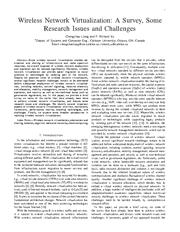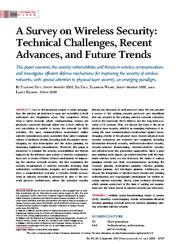A copy of this work was available on the public web and has been preserved in the Wayback Machine. The capture dates from 2017; you can also visit the original URL.
The file type is application/pdf.
Filters
Performance enhancement and analysis for IEEE 802.16e/m sleep mode operations with unsolicited grant service/real-time variable-rate connections
2010
IET Communications
The power saving class of type II (PSC II), one of the sleep mode operations in the IEEE 802.16e standard, is designed to reduce power consumption for unsolicited grant service (UGS) and real-time variablerate ...
However, the configuration of fixed-length listening windows in the PSC II incurs unnecessary energy consumption or packet loss for these types of connections. ...
Acknowledgment This work was in part funded by the Aiming for the Top University and Elite Research Center Development Plan, NSC 96-2221-E-009-016, NSC 98-2221-E-009-065, the MediaTek Research Center at ...
doi:10.1049/iet-com.2009.0173
fatcat:rolehcolwnbzhoubmbjuutfmyu
Adaptive Sleep Mode Mechanism for 3G WiMax Networks
2013
IOSR Journal of Electronics and Communication Engineering
The emerging IEEE 802.16e standard provides a new sleep mode operation for Mobile Stations (MS) to address energy efficiency. ...
Therefore, third-generation (3G) wireless standards IEEE 802.16e should provide very efficient energy conservation mechanisms to achieve longer battery life while providing enhanced user experience and ...
Kim [12] introduced an efficient power management mechanism which takes into account the remaining power. In Sleep mode, the energy consumption of MS may be reduced by introducing a sleep cycle. ...
doi:10.9790/2834-0865661
fatcat:r7qhcmsgavbshjifduurg7xcau
Performance Analysis of the Sleep Mode in WiMAX 2 Networks with Multimedia Application
2014
Journal of Applied Mathematics
Accordingly, we give the formulas for the performance measures in terms of the average response time of data packets, the energy saving ratio, and the standard deviation of the number of data packets. ...
We also develop a cost function to determine the optimal length of the sleep cycle in order to maximize the energy saving ratio while satisfying the Quality of Service (QoS) constraint on the average response ...
In [10] , the authors proposed a power-saving mechanism with binary exponential traffic indications in IEEE 802.16e/m. ...
doi:10.1155/2014/976179
fatcat:lxgfei6exfhsjgilnp5z4fgrhy
Wireless Network Virtualization: A Survey, Some Research Issues and Challenges
2015
IEEE Communications Surveys and Tutorials
ACKNOWLEDGMENT We thank the reviewers for their detailed reviews and constructive comments, which have helped to improve the quality of this paper. ...
IEEE 802.16-based Wireless Network Virtualization Several virtualization approaches focus on IEEE 802.16e&m. ...
, energy saving, interfaces, etc. ...
doi:10.1109/comst.2014.2352118
fatcat:eihz4mdguzbepowj4x42pgsuc4
A Survey on Wireless Security: Technical Challenges, Recent Advances, and Future Trends
2016
Proceedings of the IEEE
This paper examines the security vulnerabilities and threats imposed by the inherent open nature of wireless communications and to devise efficient defense mechanisms for improving the wireless network ...
Additionally, we discuss the integration of physical-layer security into existing authentication and cryptography mechanisms for further securing wireless networks. ...
., IEEE 802.16e/m) [104] , which relies on two-way authentication. The following discussions detail both the WiMAX authentication as well as the authorization and encryption processes. ...
doi:10.1109/jproc.2016.2558521
fatcat:yttlvv4vlne5hh5l4zs6qlh2ra
Spatial Diversity Scheme to Efficiently Cancel ISI and ICI in OFDM-OQAM Systems
2010
Journal of Computer Systems, Networks, and Communications
The nonemployment of the CP increases the spectral efficiency in comparison with classical CP-OFDM systems, as it does not employ the CP for its correct performance. ...
On the other hand, the MIMO technology is already available in almost all OFDM-based wireless standards (e.g., IEEE 802.11n, IEEE 802.16e/m and LTE). ...
The case of n t = 2 is considered along the paper for easiness in the results presentation and to align with all commercial implementations of the IEEE 802.11 pre-n and the proposals for all 4G-LTE systems ...
doi:10.1155/2010/576243
fatcat:z6s6nag4efdzbajsfs6vh6loua
Diversity Management in MIMO-OFDM Systems
[chapter]
2011
Recent Advances in Wireless Communications and Networks
., IEEE 802.11a/g/n, IEEE 802.16e/m, 3GPP-LTE, LTE-Advanced). ...
) that may result in further energy savings. ...
This chapter is distributed under the terms of the Creative Commons Attribution-NonCommercial-ShareAlike-3.0 License, which permits use, distribution and reproduction for non-commercial purposes, provided ...
doi:10.5772/18269
fatcat:dpoki7nfbrdxjnbrsxdesyt55m
Lightweight Mobile and Wireless Systems: Technologies, Architectures, and Services
2010
Journal of Computer Systems, Networks, and Communications
The nonemployment of the CP increases the spectral efficiency in comparison with classical CP-OFDM systems, as it does not employ the CP for its correct performance. ...
In this paper, we present two efficient integer linear programming (ILP) formulations, for optimally allocating a channel (from a pool of available channels) to an incoming call such that both "hard" and ...
Ngom thank NSERC for their support. ...
doi:10.1155/2010/420806
fatcat:qwpqrihdavfs3oak5yvuikkony
Quality-driven model-based design of multi-processor accelerators:an application to LDPC decoders
[article]
2012
The decoders of the low density parity check (LDPC) codes [2] , adopted as an advance errorcorrecting scheme in the newest wired/wireless communication standards, like IEEE 802.11n, 802.16e/m, 802.15.3c ...
For this example, a relatively high power saving of almost 2-times is achieved, even ignoring the static power P W static , and the area saving of 1.02-times compared to the traditional approach. ...
Table 1 shows the result of the row/column permutation for the rate-1/2 672-bit IEEE 802.15.3c LDPC code, which create zero-entries at the top-right and bottom-left of the PCM. ...
doi:10.6100/ir732195
fatcat:s35g3keguzhmlplmqumalno64u
Broj (Number) 1 Varaždin, srpanj 2011
J. Križanića
unpublished
802.11a/b/g/j/p/n, IEEE 802.11n)lokalnim bežičnim sustavom prijenosa • radijskoj mreži (celularni sustav) gradskih područja WiMAX (IEEE 802.16e/m) • DVB-T2 sustavu • DVB-C2 sustavu
FREKVENCIJSKOG MULTIPLEKSA ...
This mechanism saves the entry time when most of the cells have the same attribute values. ...
fatcat:5mu5kceoxzcojcmsl4qzhftxoa









